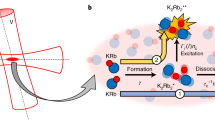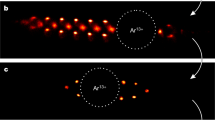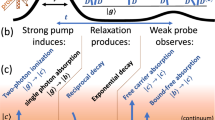Abstract
Chemical reactions at ultracold temperatures are expected to be dominated by quantum mechanical effects. Although progress towards ultracold chemistry has been made through atomic photoassociation1, Feshbach resonances2 and bimolecular collisions3, these approaches have been limited by imperfect quantum state selectivity. In particular, attaining complete control of the ground or excited continuum quantum states has remained a challenge. Here we achieve this control using photodissociation, an approach that encodes a wealth of information in the angular distribution of outgoing fragments. By photodissociating ultracold 88Sr2 molecules with full control of the low-energy continuum, we access the quantum regime of ultracold chemistry, observing resonant and nonresonant barrier tunnelling, matter–wave interference of reaction products and forbidden reaction pathways. Our results illustrate the failure of the traditional quasiclassical model of photodissociation4,5,6,7 and instead are accurately described by a quantum mechanical model8,9. The experimental ability to produce well-defined quantum continuum states at low energies will enable high-precision studies of long-range molecular potentials for which accurate quantum chemistry models are unavailable, and may serve as a source of entangled states and coherent matter waves for a wide range of experiments in quantum optics10,11.
This is a preview of subscription content, access via your institution
Access options
Subscribe to this journal
Receive 51 print issues and online access
$199.00 per year
only $3.90 per issue
Buy this article
- Purchase on Springer Link
- Instant access to full article PDF
Prices may be subject to local taxes which are calculated during checkout





Similar content being viewed by others
References
Jones, K. M., Tiesinga, E., Lett, P. D. & Julienne, P. S. Ultracold photoassociation spectroscopy: long-range molecules and atomic scattering. Rev. Mod. Phys. 78, 483–535 (2006)
Chin, C., Grimm, R., Julienne, P. & Tiesinga, E. Feshbach resonances in ultracold gases. Rev. Mod. Phys. 82, 1225–1286 (2010)
Ospelkaus, S. et al. Quantum-state controlled chemical reactions of ultracold potassium-rubidium molecules. Science 327, 853–857 (2010)
Zare, R. N. & Herschbach, D. R. Doppler line shape of atomic fluorescence excited by molecular photodissociation. Proc. IEEE 51, 173–182 (1963)
Zare, R. N. Photoejection dynamics. Mol. Photochem. 4, 1–37 (1972)
Choi, S. E. & Bernstein, R. B. Theory of oriented symmetric-top molecule beams: precession, degree of orientation, and photofragmentation of rotationally state-selected molecules. J. Chem. Phys. 85, 150–161 (1986)
Zare, R. N. Photofragment angular distributions from oriented symmetric-top precursor molecules. Chem. Phys. Lett. 156, 1–6 (1989)
Skomorowski, W., Pawłowski, F., Koch, C. P. & Moszynski, R. Rovibrational dynamics of the strontium molecule in the A1, c3∏u, and a3 manifold from state-of-the-art ab initio calculations. J. Chem. Phys. 136, 194306 (2012)
Borkowski, M. et al. Mass scaling and nonadiabatic effects in photoassociation spectroscopy of ultracold strontium atoms. Phys. Rev. A 90, 032713 (2014)
Grangier, P., Aspect, A. & Vigue, J. Quantum interference effect for two atoms radiating a single photon. Phys. Rev. Lett. 54, 418–421 (1985)
Kheruntsyan, K. V., Olsen, M. K. & Drummond, P. D. Einstein–Podolsky–Rosen correlations via dissociation of a molecular Bose–Einstein condensate. Phys. Rev. Lett. 95, 150405 (2005)
McGuyer, B. H. et al. Precise study of asymptotic physics with subradiant ultracold molecules. Nature Phys. 11, 32–36 (2015)
Reid, K. L. Photoelectron angular distributions. Annu. Rev. Phys. Chem. 54, 397–424 (2003)
Hockett, P., Wollenhaupt, M., Lux, C. & Baumert, T. Complete photoionization experiments via ultrafast coherent control with polarization multiplexing. Phys. Rev. Lett. 112, 223001 (2014)
Rakitzis, T. P., Kandel, S. A., Alexander, A. J., Kim, Z. H. & Zare, R. N. Photofragment helicity caused by matter–wave interference from multiple dissociative states. Science 281, 1346–1349 (1998)
Garcia, G. A., Nahon, L. & Powis, I. Two-dimensional charged particle image inversion using a polar basis function expansion. Rev. Sci. Instrum. 75, 4989–4996 (2004)
McGuyer, B. H. et al. High-precision spectroscopy of ultracold molecules in an optical lattice. New J. Phys. 17, 055004 (2015)
McGuyer, B. H. et al. Control of optical transitions with magnetic fields in weakly bound molecules. Phys. Rev. Lett. 115, 053001 (2015)
Beswick, J. A. & Zare, R. N. On the quantum and quasiclassical angular distributions of photofragments. J. Chem. Phys. 129, 164315 (2008)
Seideman, T. The analysis of magnetic-state-selected angular distributions: a quantum mechanical form and an asymptotic approximation. Chem. Phys. Lett. 253, 279–285 (1996)
González-Férez, R. & Koch, C. P. Enhancing photoassociation rates by nonresonant-light control of shape resonances. Phys. Rev. A 86, 063420 (2012)
Volz, T. et al. Feshbach spectroscopy of a shape resonance. Phys. Rev. A 72, 010704(R) (2005)
Mark, M. et al. Stückelberg interferometry with ultracold molecules. Phys. Rev. Lett. 99, 113201 (2007)
Knoop, S. et al. Metastable Feshbach molecules in high rotational states. Phys. Rev. Lett. 100, 083002 (2008)
Zhang, X. et al. Spectroscopic observation of SU(N)-symmetric interactions in Sr orbital magnetism. Science 345, 1467–1473 (2014)
Bartenstein, M. et al. Precise determination of 6Li cold collision parameters by radio-frequency spectroscopy on weakly bound molecules. Phys. Rev. Lett. 94, 103201 (2005)
Salumbides, E. J. et al. Bounds on fifth forces from precision measurements on molecules. Phys. Rev. D 87, 112008 (2013)
Lane, I. C. Production of ultracold hydrogen and deuterium via Doppler-cooled Feshbach molecules. Phys. Rev. A 92, 022511 (2015)
Lemeshko, M., Krems, R. V., Doyle, J. M. & Kais, S. Manipulation of molecules with electromagnetic fields. Mol. Phys. 111, 1648–1682 (2013)
Stapelfeldt, H. & Seideman, T. Colloquium: Aligning molecules with strong laser pulses. Rev. Mod. Phys. 75, 543–557 (2003)
Reinaudi, G., Osborn, C. B., McDonald, M., Kotochigova, S. & Zelevinsky, T. Optical production of stable ultracold 88Sr2 molecules. Phys. Rev. Lett. 109, 115303 (2012)
McGuyer, B. H. et al. Nonadiabatic effects in ultracold molecules via anomalous linear and quadratic Zeeman shifts. Phys. Rev. Lett. 111, 243003 (2013)
Reinaudi, G., Lahaye, T., Wang, Z. & Guéry-Odelin, D. Strong saturation absorption imaging of dense clouds of ultracold atoms. Opt. Lett. 32, 3143–3145 (2007)
Wrede, E., Wouters, E. R., Beckert, M., Dixon, R. N. & Ashfold, M. N. R. Quasiclassical and quantum mechanical modeling of the breakdown of the axial recoil approximation observed in the near threshold photolysis of IBr and Br2 . J. Chem. Phys. 116, 6064–6071 (2002)
Apfelbeck, F. Photodissociation Dynamics of Ultracold Strontium Dimers. MSc thesis, Ludwig Maximilian University of Munich (2015)
O’Keeffe, P. et al. A photoelectron velocity map imaging spectrometer for experiments combining synchrotron and laser radiations. Rev. Sci. Instrum. 82, 033109 (2011)
Acknowledgements
We gratefully acknowledge ONR grant N000-14-14-1-0802, NIST award 60NANB13D163, and NSF grant PHY-1349725 for partial support of this work, and thank A. T. Grier, G. Z. Iwata and M. G. Tarallo for discussions. R.M. acknowledges the Foundation for Polish Science for support through the MISTRZ programme.
Reviewer Information Nature thanks D. Chandler and the other anonymous reviewer(s) for their contribution to the peer review of this work.
Author information
Authors and Affiliations
Contributions
M.M., B.H.M., F.A., C.-H.L. and T.Z. designed the experiments, carried out the measurements and interpreted the data. I.M. and R.M. carried out the calculations and interpreted the data. All authors contributed to the manuscript.
Corresponding author
Ethics declarations
Competing interests
The authors declare no competing financial interests.
Extended data figures and tables
Extended Data Figure 1 Angular distributions for the M1/E2 photodissociation of 1g(vi = −1, Ji = 1, Mi = 0) state with p = 0 to the ground continuum.
Images are arranged as in Fig. 4. The experimental images are labelled by the continuum energy ε/h in MHz. To improve contrast, the strong centre dot from spontaneous decay, as seen in Fig. 3b, was removed before processing and is covered by a box. The theoretical images are calculated using a quantum chemistry model.
Extended Data Figure 2 Comparison of quasiclassical and quantum mechanical (QM) theory with experimental (Exp) images for selected cases from Fig. 4 and Extended Data Fig. 3.
The quasiclassical predictions follow from equations (3) and (4) assuming β20 = 2 for ΔΩ = 0 and −1 for |ΔΩ| = 1. (The quantum mechanical predictions slightly differ from those displayed in Fig. 4 and Extended Data Fig. 3 because they are the full quantum mechanical calculations given in Supplementary Tables 2 and 3.) As before, coloured dots indicate the level of quasiclassical agreement.
Extended Data Figure 3 Photodissociation of molecules near the 1S + 3P1 threshold to the ground-state continuum.
In contrast to Fig. 4, here the initial states are  with (vi, Ji) = (−4, 1) or (−3, 3) as indicated. These initial states lead to nearly identical distributions as those with the 1u initial states, contrary to the quasiclassical picture. As before, compatibility with the quasiclassical approximation is indicated by the coloured dots.
with (vi, Ji) = (−4, 1) or (−3, 3) as indicated. These initial states lead to nearly identical distributions as those with the 1u initial states, contrary to the quasiclassical picture. As before, compatibility with the quasiclassical approximation is indicated by the coloured dots.
Extended Data Figure 4 Spontaneous photodissociation of molecules prepared in  states.
states.
a, Absorption images of angular distributions versus Mi. Theoretical simulations using equation (5) are shown underneath. A short expansion time was used to increase visibility. b, For quantitative analysis, another image (inset) of the Mi = 0 case was taken with a longer expansion time and analysed with the pBasex algorithm. The extracted fragment radial distribution shows a focusing around a certain kinetic energy, which was determined by fitting with a Gaussian (red curve). Correcting for an offset due to the lattice depth35, this energy corresponds to a shape resonance with a binding energy of −66 ± 3 MHz. c, The extracted fragment angular distribution qualitatively matches the calculation (red curve) of equation (5).
Supplementary information
Supplementary Information
This file contains Supplementary Methods, Supplementary Tables 1-3 and Supplementary References. (PDF 181 kb)
Rights and permissions
About this article
Cite this article
McDonald, M., McGuyer, B., Apfelbeck, F. et al. Photodissociation of ultracold diatomic strontium molecules with quantum state control. Nature 535, 122–126 (2016). https://doi.org/10.1038/nature18314
Received:
Accepted:
Published:
Issue Date:
DOI: https://doi.org/10.1038/nature18314
This article is cited by
-
Mapping partial wave dynamics in scattering resonances by rotational de-excitation collisions
Nature Chemistry (2022)
-
Molecular lattice clock with long vibrational coherence
Nature Physics (2019)
-
Quantum control of light-induced reactions
Nature (2016)
Comments
By submitting a comment you agree to abide by our Terms and Community Guidelines. If you find something abusive or that does not comply with our terms or guidelines please flag it as inappropriate.




 states.
states.